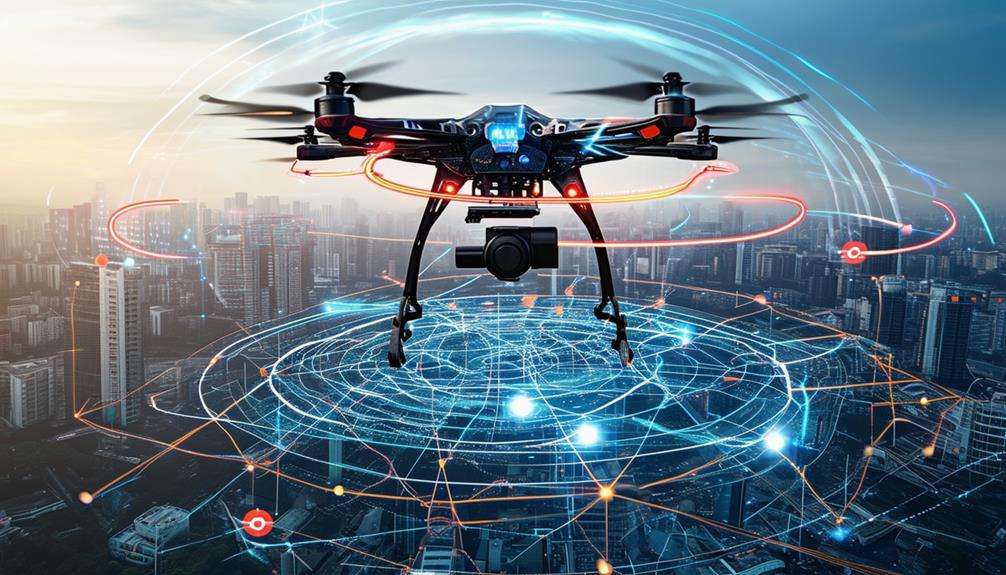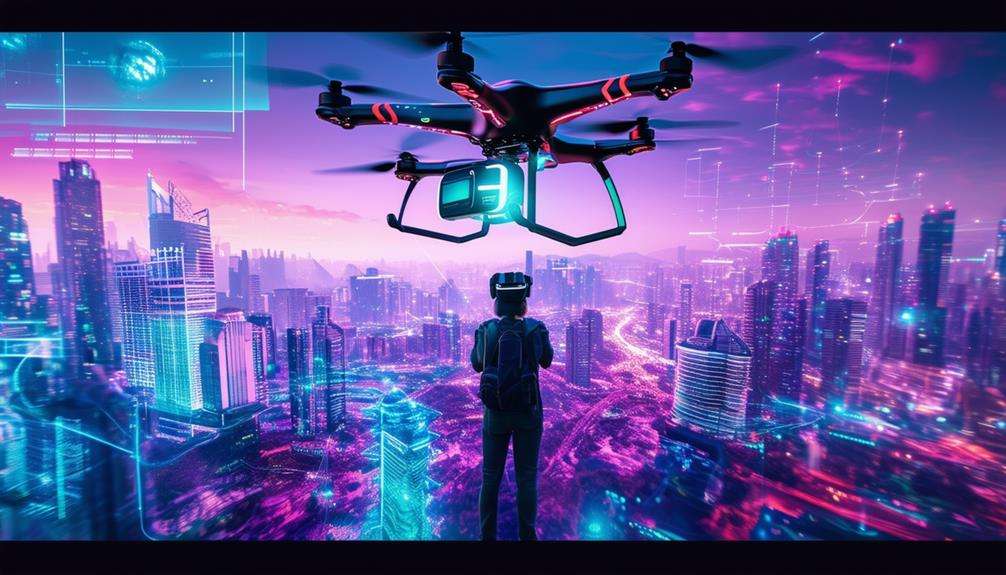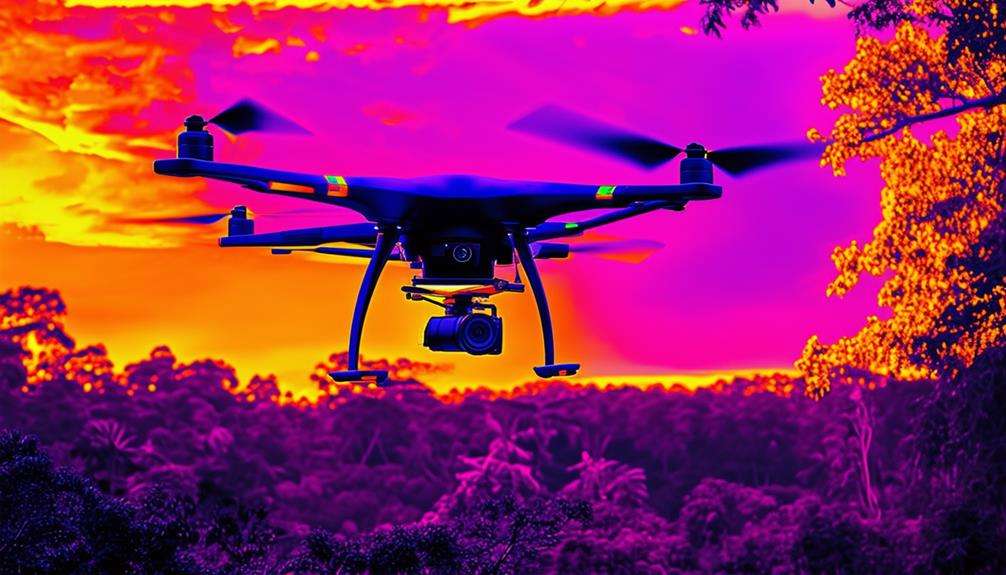Battery Life and Power Systems in Drones
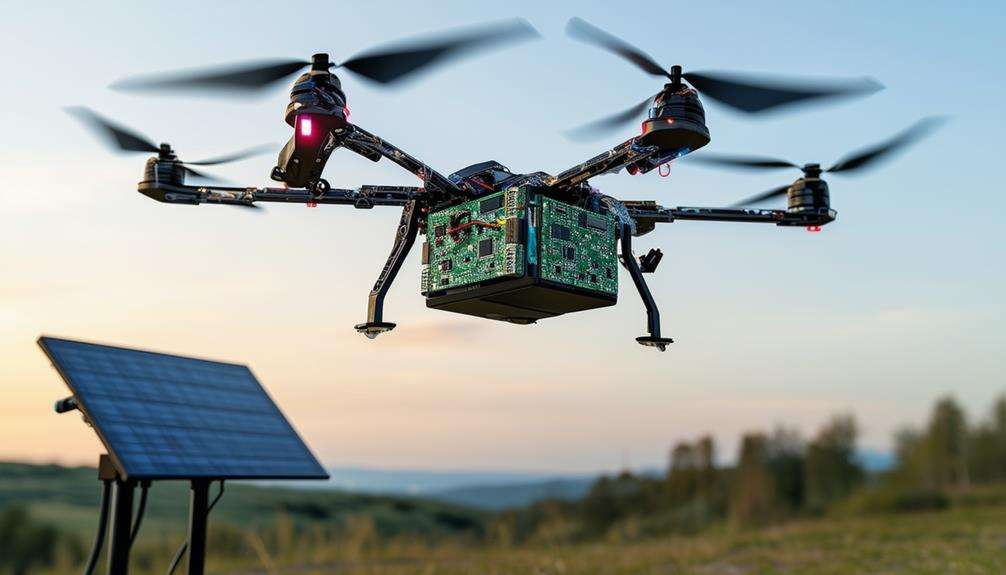
When evaluating drones, battery life and power systems are crucial factors to consider. The type of battery—whether lithium polymer (LiPo) or lithium-ion (Li-ion)—significantly influences flight duration. Additionally, environmental conditions and battery management practices are critical for optimal performance.
Advances in battery technology promise longer flight times and enhanced reliability. To maximize battery lifespan and efficiency, understanding best practices in battery management is essential. Let's explore how innovations are shaping the future of drone power systems.
Importance of Battery Life
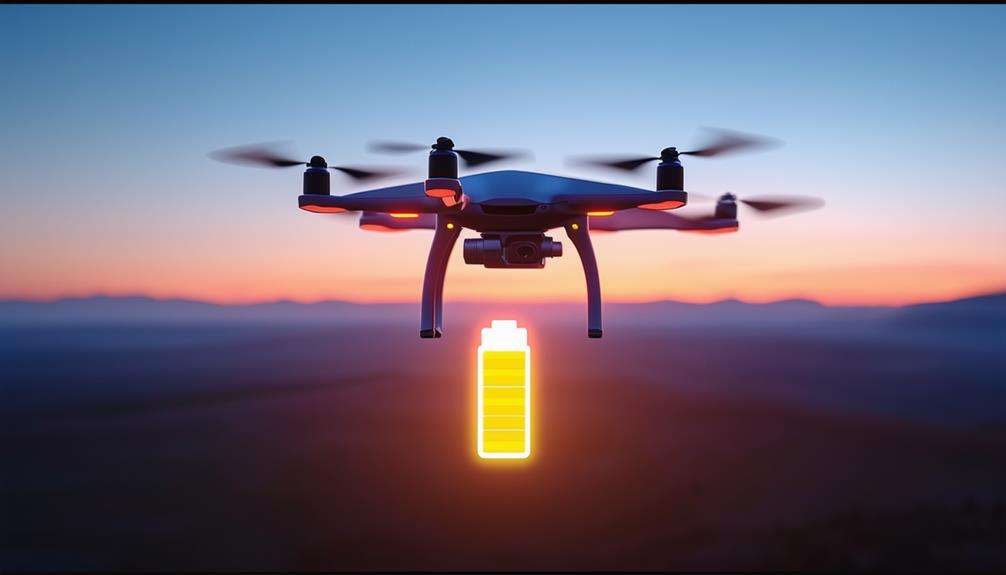
Battery life is a crucial factor in a drone's efficiency and usability, directly influencing how long it can stay airborne. For extended missions, a longer battery life is indispensable, allowing you to cover more ground, complete tasks without frequent recharges, and ultimately improve productivity. Whether you're engaged in aerial photography, agricultural mapping, or search and rescue operations, maximizing flight time is essential for success.
Moreover, battery life significantly impacts safety. A sudden power loss mid-flight isn't just inconvenient; it's risky. Extended battery life ensures that your drone can safely return to its starting point or designated landing zone, thereby minimizing risks. This reliability is especially crucial in high-stakes environments where human lives and valuable equipment are at stake.
Advances in battery technology are continually extending the capabilities of drones. Improved battery performance translates to longer flight times and better efficiency, reducing the overall cost of drone operations and making them more sustainable in the long run. Therefore, prioritizing battery life enhances not only flight duration but also performance and safety across the board.
Types of Drone Batteries
Understanding the different types of drone batteries is crucial for optimizing your drone's performance and meeting specific flight requirements. The most common types include lithium polymer (LiPo), lithium-ion (Li-ion), and nickel-cadmium (NiCd) batteries. Each type has unique characteristics that can affect your drone's performance.
LiPo batteries are the most popular choice due to their high energy density and lightweight design. They support high discharge rates, essential for delivering the power required for demanding maneuvers and extended flight times. When selecting a LiPo battery, consider factors like capacity, voltage, and discharge rate to ensure compatibility with your drone.
Li-ion batteries offer longer life cycles and better energy retention over time, but they generally have lower discharge rates compared to LiPo batteries. This makes them suitable for drones that require stable power consumption over extended periods rather than bursts of high power.
Nickel-cadmium batteries are less common in modern drones due to their lower energy density and environmental concerns, but they're known for their durability and ability to perform well in extreme temperatures.
Top drone battery brands like Tattu, Hobbyking, T-DRONES ARES, and Infinity offer reliable options tailored to various drone applications. By choosing the right battery, you can enhance your drone's performance and meet your specific flying needs.
Battery Technologies
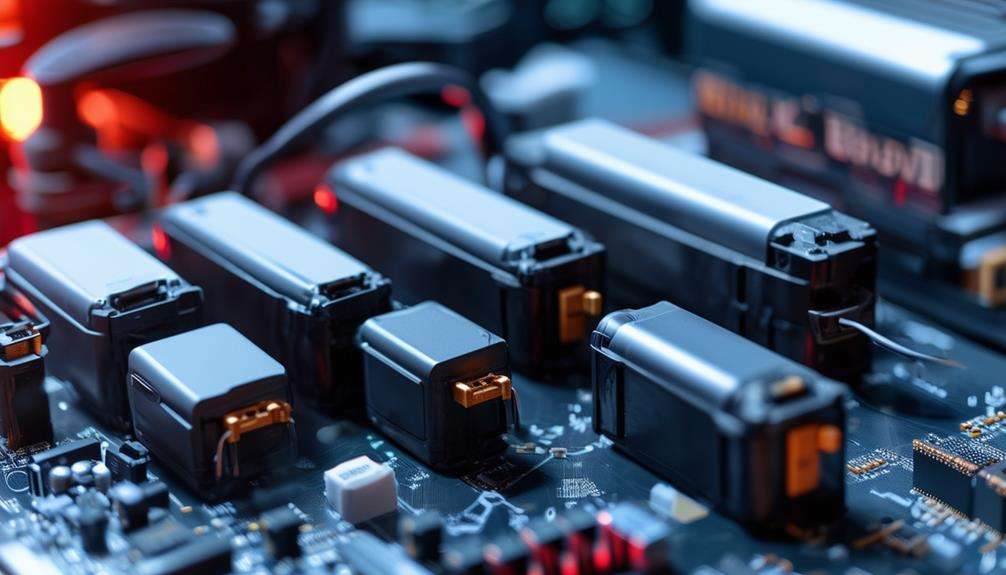
To optimize your drone's performance, it's crucial to understand the different battery technologies available. Lithium-ion (Li-ion) and lithium polymer (LiPo) batteries are the most common choices due to their high energy and power density, allowing for longer flight times and better performance.
Li-ion batteries are known for their high capacity but can be prone to overheating during charging and operation, necessitating strict safety measures. This is due to exothermic reactions that can occur within the battery. LiPo batteries, on the other hand, offer a lightweight alternative with higher capacity and better power density, making them ideal for drones.
Manufacturers continually work to improve battery performance while reducing the weight of the drone airframe. This balance is essential for maximizing flight efficiency and duration. However, it's important to be cautious of overcharging, which can happen due to incorrect charge settings or cell imbalances in multi-battery chargers.
Safety advancements, such as high-voltage compatible secondary protection fuses like the Dexerials Self Control Protector (SCP), are essential. These features help prevent battery-related incidents, ensuring your drone remains safe and reliable during operation. Understanding these technologies will help you make informed decisions and achieve the best performance from your drone.
Factors Affecting Flight Time
To optimize your drone's flight time, consider both battery capacity and environmental conditions. While larger batteries can extend flight duration, factors such as wind, temperature, and altitude significantly impact performance.
Battery Capacity Impact
A drone's flight time is fundamentally determined by its battery capacity, making it a crucial factor in effective operational planning. This capacity, typically measured in milliamp-hours (mAh), directly influences how long your drone can remain airborne. Higher capacity batteries supply more power, resulting in longer flight durations. Understanding this relationship allows you to optimize your drone's efficiency and overall performance.
Refer to the table below to visualize the impact of varying battery capacities on flight times:
| Battery Capacity (mAh) | Flight Time (Minutes) |
|---|---|
| 1000 | 10 |
| 2000 | 20 |
| 3000 | 30 |
| 4000 | 40 |
As demonstrated, drones equipped with higher milliamp-hour batteries experience extended flight times. This correlation is crucial for planning drone operations, especially those that necessitate prolonged air time. Selecting the appropriate battery capacity ensures your drone operates efficiently, balancing power requirements with flight duration.
Environmental Conditions Influence
Understanding how environmental conditions impact your drone's battery life and flight time is crucial for effective operation planning. These conditions can greatly influence your drone's performance, and knowing what to expect can help you optimize your flying sessions.
- High temperatures: Elevated temperatures decrease battery efficiency, leading to shorter flight times. The heat accelerates chemical reactions inside the battery, causing faster degradation.
- Cold weather: Conversely, cold weather slows down these chemical reactions, reducing battery performance and flight time. Keep your batteries warm before flying in colder climates.
- Windy conditions: Strong winds force your drone to work harder to maintain stability, increasing power consumption and decreasing flight time. Plan your flights when the weather is calm to conserve battery life.
- High altitudes: At higher altitudes, reduced oxygen levels affect the battery's performance, leading to shorter flight times. Exercise caution when flying in mountainous or elevated regions.
- Humid environments: High humidity can cause corrosion in battery terminals, impacting overall efficiency and battery lifespan.
Battery Management Tips
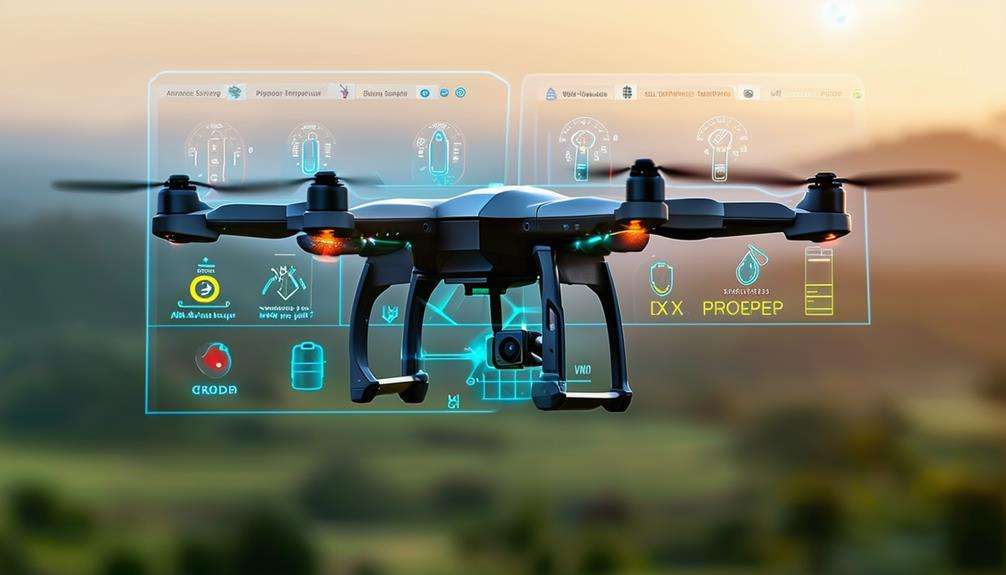
Proper battery management ensures your drone remains reliable and safe during flights. Effective management starts with monitoring cell voltage. Ensure each cell within the battery maintains balanced charging and avoids deep discharge. Keeping cell voltage above 3.3V during use and storing them at around 3.8V per cell can significantly improve battery lifespan.
Drone safety heavily relies on the physical condition of your batteries. Regularly inspect for any physical damage or swelling, as these issues can lead to severe malfunctions or even fires. Additionally, always monitor battery temperature. Overheating can damage internal components and pose a safety risk. Use a temperature monitor to ensure batteries stay within the recommended range during both charging and discharging.
Balanced charging is crucial for maintaining battery health. Invest in a quality balanced charger to ensure each cell is charged equally. This not only extends the battery's longevity but also prevents potential safety hazards caused by uneven cell voltages.
Innovations in Battery Tech
Recent breakthroughs in battery technology are revolutionizing the drone industry by providing longer flight times and enhanced safety features. Advances in lithium-ion battery technology are especially promising, with current energy densities of 150-200 Wh/kg expected to rise to as much as 400 Wh/kg. This increase promises significantly extended drone operation times.
Key innovations include:
- Energy Density: Increasing the energy density of lithium-ion batteries allows drones to fly longer without needing a recharge, enhancing efficiency and versatility.
- Safety Features: Advanced safety mechanisms, such as the Dexerials Self Control Protector (SCP), prevent overcharging and other battery-related issues, ensuring safer flights.
- Battery Management Systems: Improved systems for balancing cells and maintaining correct settings reduce the risk of overcharging, thereby enhancing overall battery performance.
- Weight Optimization: Efforts to reduce battery weight aim to improve drone functionality and maneuverability without sacrificing power.
These advancements in battery technology are transforming drone operation, offering better performance, safety, and efficiency. With ongoing research, even greater improvements are on the horizon.
Industry Applications
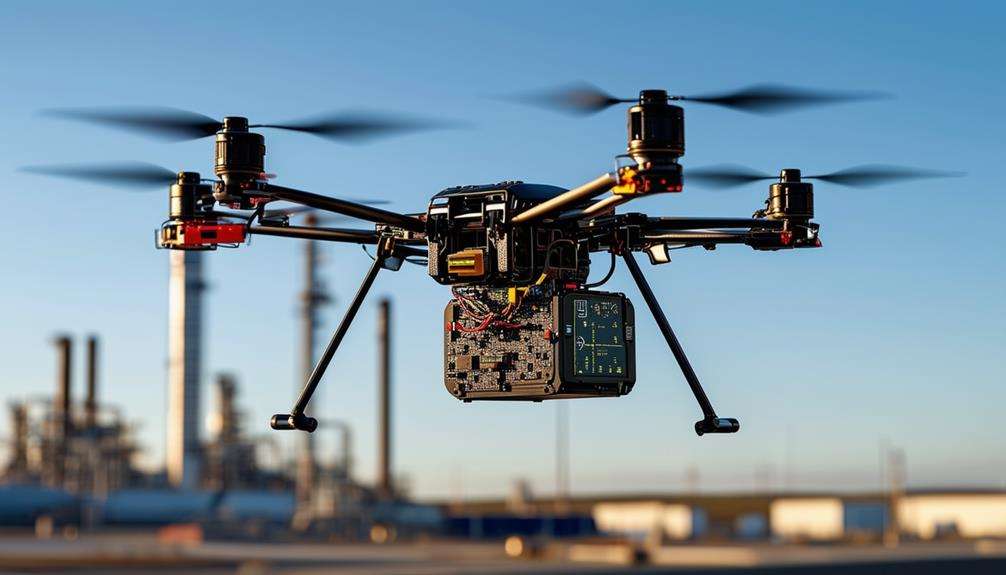
Drones are transforming various industries, including agriculture, delivery, and public safety, by offering innovative solutions and enhancing operational efficiency. In agriculture, drones are indispensable for tasks such as crop monitoring, pesticide spraying, and field health assessments. These applications rely on high-energy UAV batteries to ensure maximum flight time, thereby enhancing productivity in large-scale farming operations.
In infrastructure inspection, search and rescue missions, and firefighting operations, drones equipped with thermal imaging cameras provide invaluable support. These drones necessitate dependable energy storage systems to perform extensive tasks without frequent recharging. Advances in commercially available drone batteries have led to more robust and durable options suitable for these demanding applications.
Leading e-commerce companies are exploring last-mile delivery drones to expedite logistics and enhance delivery efficiency. These drones require powerful UAV batteries to manage multiple deliveries in a single flight.
In environmental monitoring, drones play a critical role in tracking wildlife, studying ecosystems, and observing changes in natural landscapes, necessitating long-lasting energy storage solutions to cover extensive areas.
In security and surveillance, autonomous drones patrol sensitive areas and monitor crowds to enhance public safety. For these applications, the longest flight time and high energy efficiency of UAV batteries are essential to ensure continuous and reliable surveillance.
Future Trends in Power Systems
Solar-powered drones are set to revolutionize flight times, thanks to advancements in solar energy capture. Additionally, next-generation battery technologies promise over 1,000 charge cycles and higher energy densities. These innovations won't only enhance performance but also increase the safety and reliability of drone operations.
Solar-Powered Drone Innovations
As solar technology advances, solar-powered drones are transforming long-endurance missions. These drones use photovoltaic panels to convert sunlight into electrical energy, enabling extended flight durations and reducing dependence on traditional batteries. By harnessing renewable energy, solar-powered drones offer a sustainable and eco-friendly alternative to fossil fuel-powered counterparts, significantly lowering carbon emissions.
Solar-powered drones excel in tasks requiring continuous operation, such as:
- Environmental Monitoring: Track wildlife, monitor deforestation, and observe climate patterns over large areas without frequent recharging.
- Telecommunications: Provide internet services in remote locations where laying cables is impractical.
- Surveillance: Conduct long-term surveillance for border security or disaster monitoring.
- Technological Advancement: Propel innovations in solar efficiency and drone design, pushing the boundaries of what's possible.
With advances in lightweight and efficient solar panels, these drones can stay airborne for weeks or even months, unlocking new possibilities in various fields. Imagine a drone continuously patrolling a forest to prevent illegal logging or providing uninterrupted communication links during natural disasters. Solar-powered drones aren't just a glimpse of the future; they're revolutionizing our current approach to power systems.
Advanced Battery Technologies
How can cutting-edge battery technologies revolutionize the future of drone power systems? By increasing battery voltage and targeting over 1,000 charge cycles, manufacturers are enhancing battery performance and extending drone flight times. With a goal of achieving 400 Wh/kg energy density, these advanced battery technologies promise more efficient and longer-lasting power systems for drones.
Safety advancements are equally critical. High-voltage compatible secondary protection fuses, such as the Dexerials Self Control Protector (SCP), play a vital role in preventing battery incidents. These fuses ensure lithium-ion batteries don't overheat, a significant risk due to exothermic reactions, especially when using multi-battery chargers and misbalanced cells.
Efforts to reduce the overall airframe weight of drones while optimizing battery performance are ongoing. This dual approach enhances drone operation and efficiency, addressing challenges such as limited flight duration and payload capacity.
Conclusion
In summary, battery life and power systems are pivotal for maximizing drone efficiency and functionality. Understanding different battery types, technologies, and management practices allows for optimized flight time and reliable operations.
With continuous innovations and emerging trends, advancements in battery performance and safety are inevitable. Embracing these developments will keep you at the forefront of the evolving drone industry, ensuring you make the most of your airborne missions.


